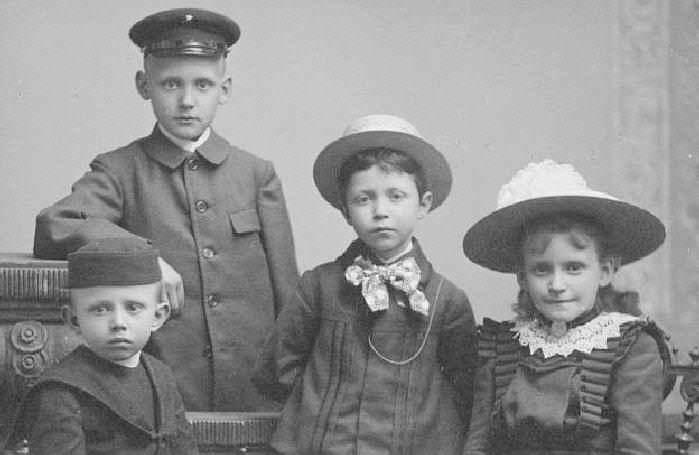
German Families: Osnabrück Family (about 1906)

Figure 1.--This wonderful German image in the early 20th century, probably about 1906, shows a younger boy wearing one of these caps with a sailor suit. The portrait shows some of the different types of headwear worn by German children of different ages and gender. Our HBC reader reports, "The portrait was taken in Osnabrück, Germany. About 1906 seems a good guess given Willi's age. The back of the photograph has the names of the children. One is Willi (Wilhelm) Ernst zu Eikern (sounds a little noble)." Wilhelm was born in 1896 and died in 1955. It is not altogether clear which boy is Wilhelm, but a German reader thinks it is the oldest boy in the back. He looks to be about 10 years old. That means that the photograph was taken about 1906. Image courtesy of the BP collection.
|
|
This wonderful German image in the early 20th century, probably the early 1900s, shows a younger boy wearing one of these caps with a sailor suit. The portrait shows some of the different types of headwear worn by German children of different ages and gender. Our HBC reader reports, "The portrait was taken in Osnabrück, Germany. About 1906 seems a good guess given Willi's age. The back of the photograph has the names of the children. One is Willi (Wilhelm) Ernst zu Eikern (sounds a little noble)." This image is especially interesting because of the variety of headwear the boys are wearing. As our reader explains, headwear was much more importat in the early 20th century than is the case today.
Eikern and Sager Family
This wonderful German image in the early 20th century, probably the early 1900s, provides us a great view of a German family at the turn of the 20th century, The backside of the photograph reveals the name of the older boy: Willi (Wilhelm) Ernst zu Eikern. In trying to interpre these old photographs, which often do not idntify the individuals, we usually assume that the children are all in one family. This was not, however, always the case. The children here were: Willi Ernst zu Eikern, Edi Sager, Papa (meaning father), and Lene Sager. So a child of onethe individuals must have written the names years after it was taken. We are guessing that the children were probably cousins. Another reader tells us that Willi was born December 14, 1896. As he looks about 10 years old, we know that the children had their portrait taken about 1906. We also know they lived in Osnabrück, Germany. They look to be members of an affluent family. The body language, however, dies not suggest the children were especially close, almost like strangers. This might also be the way thevphotographer posed them.
Reader Comments
A German reader provides some interesting insights on this portrait, "First the name: “… zu …” is in the German language not necessarily the name of a noble family; it may also denote just the place of coming or living. Institutions also often say “… zu (a town)”. “Eikern” may be translated to “kernel of an egg” (yolk?), not a good name for a noble family. Looking with Google it seems to be a name of northern Germany, The Netherlands or from Scandinavia, just a village name or so. In the first half of the last century which I am aware of a person in Germany never left home without a headwear, children included, winter and summer. There were a lot of different styles, regional differences, fashion, social status. From the girl´s blouse and hat I assume that it was an affluent family. Also the middle aged boy (?) looks affluent.">
Boys' Headwear
This image is especially interesting because of the variety of headwear the boys are wearing. As our reader explains, headwear was much more importat in the early 20th century than is the case today.
Military style cap
Our reader writes, "I am wondering about the “Kittel” of the elder boy standing behind, it looks like a worker´s habit, his cap like his father´s office cap as a clerk working for a community service, a railway, the mail service or the like." HBC thought the older boy might be wearing a kind of German school cap with a military style.
Boater
The middle boy wears a boater. We are unsure how common these were in Germany. The boy here seems a little younger than the American and British boys wer have seen wearing them.
Unknown cap
We are not sure what the term is for the cap the younger boy here is wearing. This was a popular cap style in America for younger boys during the latec 19th century. We are not sure how common it was in Germany. Our rerader writes, "And the small boy´s cap looks like the cap of a miner or of a chimney sweep. – it is a difficult situation !"
HBC

Navigate the Historic Boys' Clothing Web Site:
[Return to the Main German 20th century family page]
[Introduction]
[Activities]
[Biographies]
[Chronologies]
[Countries]
[Girls]
[Style Index]
[Biblioraphies]
[Contributions]
[Frequently Asked Questions]
[Glossaries]
[Registration]
[Tools]
[Boys' Clothing Home]
Navigate the Historic Boys' Clothing Web chronological pages:
[The 1880s]
[The 1890s]
[The 1900s]
[The 1910s]
[The 1920s]
[The 1930s]
[The 1940s]
[The 1950s]
[The 1960s]
[The 1970s]
[The 1980s]
[The 1990s]
Navigate the Historic Boys' Clothing Web headgear pages:
[Return to the Main unknown cap style page]
[Return to the Main hat page]
[Return to the Main cap page]
[Sailor hats]
[Sailor caps]
[School caps]
Created: 2:21 AM 11/18/2004
Last updated: 10:33 PM 5/11/2007



